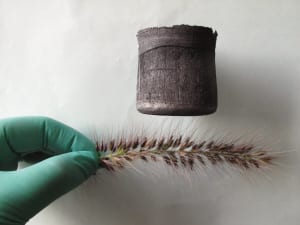Our guest writer Hua-Jie Zhu is from the Chinese Center for Chirality, Department of Chemistry and Chemical Engineering, the Key Laboratory of Medicinal Chemistry and Molecular Diagnostics of Education Committee of China, Hebei University.
Ultralight cellular materials, which find applications in many different areas, have been an area of interest for researchers since the 1930s.1-7 A very recent example is the carbon aerogel reported by H. Sun , Z. Xu , and C. Gao earlier this year (pictured below).8 They reported that the density of this material is only 0.16 mg/ml3, one sixth that of air. Herein, I show that it is not suitable to use the concept of density to characterize these ultralight materials. A more scientific conception is needed for this research area.

An ultralight material that can stand on a “dog’s tail” (Setaira viridis (L.) Beauv). Image reproduced with permission from reference 8, copyright Wiley-VCH Verlag GmbH & Co. KGaA.
Why is the concept of “normal” density not suitable for describing ultralight materials? It is well known that wood can float on water if the density of the wood is less than that of water’s. A hot-air balloon can rise and fly in the sky because the overall weight of the balloon is less than the weight of air that is displaced by the volume of the balloon in the sky. It therefore follows that, once the density of an ultralight material is only one of sixth of air, the ultralight material will absolutely rise and fly in the air just as a hot-air balloon does, at least based on the common sense that everyone has in mind. Unfortunately, we do not see these materials either floating or rising into the air like a hot-air balloon. They still need something, even something as fragile as a flower (as demonstrated in the figure), to support them. Why can’t this ultralight material, with its density one sixth of air, fly like a hot-air balloon in the sky?
The key to this question is the air. As the surface of the ultralight material looks compact, this creates the false impression that the entire structure is full of the material. This is not correct. It is not possible to keep the air out of the ultralight material volume. In other words, due to the huge number of tiny holes within the material, air permeates its structure, and because the weight of the ultralight material and the air together is heavier than the weight of the air displaced by the same volume of ultralight material, an apparent density larger than the air’s is observed.
Therefore, to use density can easily give a false impression. In fact, there is another concept that can show how light the material is. I would suggest using the volume density (Vd), which is defined as:
![]()
Where V is the volume of the foam (bubble), and W is the weight of material using to create it. The unit is cm3/g, and this value is easy to compute and to compare.
The use of density for ultralight materials is, of course, possible. However, not everyone, particularly not materials scientists, understand the details behind the phenomena. To continue to use this concept may give the wrong impression: the density of these materials looks like magic! Lower density wood can float on the water, so why can’t lower density ultralight material float or act as a hot-air balloon in the sky?
References
[1] S. S. Kistler , Nature 1931 , 127 , 741.
[ 2] Y. Zhao , C. G. Hu , Y. Hu , H. H. Cheng , G. Q. Shi , L. T. Qu , Angew.Chem. Int. Ed. 2012 , 51 , 11174.
[ 3 ] Z. P. Chen , W. C. Ren , L. B. Gao , B. L. Liu , S. F. Pei , H. M. Cheng ,Nat. Mater. 2011 , 10 , 424 .
[ 4 ] A. Cao , P. L. Dickrell , W. G. Sawyer , M. N. Ghasemi-Nejhad ,P. M. Ajayan , Science 2005 , 310 , 1307 .
[ 5 ] M. Xu , D. N. Fubata , T. Yamada , M. Yumura , K. Hata , Science 2010 ,330 , 1364 .
[ 6 ] D. P. Hashim , N. T. Narayanan , J. M. Romo-Herrera , D. A. Cullen ,M. G. Hahm , P. Lezzi , J. R. Suttle , D. Kelkhoff , E. Muñoz-Sandoval ,S. Ganguli , A. K. Roy , D. J. Smith , R. Vajtai , B. G. Sumpter ,V. Meunier , H. Terrones , M. Terrones , P. M. Ajayan , Sci. Rep. 2012 , 2 ,363 .
[ 7 ] Y. X. Xu , K. X. Sheng , C. Li , G. Q. Shi , ACS Nano 2010 , 4 , 4324 .
[8] H. Sun , Z. Xu , and C. Gao Adv. Mater. 2013, 25, 2554.

















